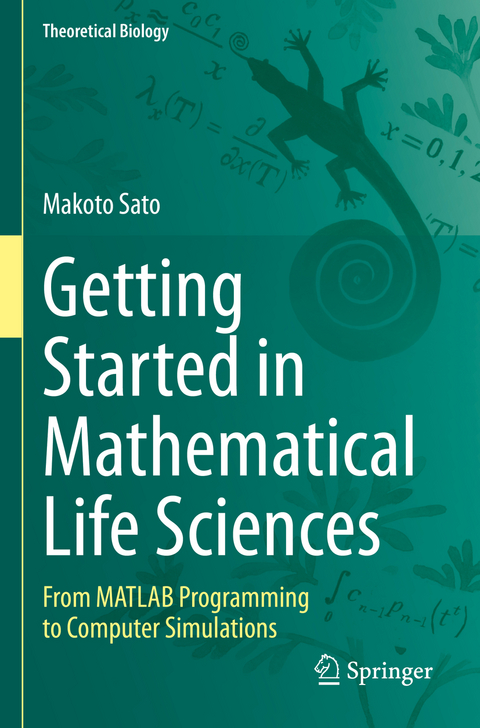
Getting Started in Mathematical Life Sciences
From MATLAB Programming to Computer Simulations
Seiten
2024
|
1st ed. 2022
Springer Verlag, Singapore
978-981-19-8259-0 (ISBN)
Springer Verlag, Singapore
978-981-19-8259-0 (ISBN)
This book helps the reader make use of the mathematical models of biological phenomena starting from the basics of programming and computer simulation. Computer simulations based on a mathematical model enable us to find a novel biological mechanism and predict an unknown biological phenomenon. Mathematical biology could further expand the progress of modern life sciences. Although many biologists are interested in mathematical biology, they do not have experience in mathematics and computer science. An educational course that combines biology, mathematics, and computer science is very rare to date. Published books for mathematical biology usually explain the theories of established mathematical models, but they do not provide a practical explanation for how to solve the differential equations included in the models, or to establish such a model that fits with a phenomenon of interest.
MATLAB is an ideal programming platform for the beginners of computer science. This book starts from the very basics about how to write a programming code for MATLAB (or Octave), explains how to solve ordinary and partial differential equations, and how to apply mathematical models to various biological phenomena such as diabetes, infectious diseases, and heartbeats. Some of them are original models, newly developed for this book. Because MATLAB codes are embedded and explained throughout the book, it will be easy to catch up with the text. In the final chapter, the book focuses on the mathematical model of the proneural wave, a phenomenon that guarantees the sequential differentiation of neurons in the brain. This model was published as a paper from the author’s lab (Sato et al., PNAS 113, E5153, 2016), and was intensively explained in the book chapter “Notch Signaling in Embryology and Cancer”, published by Springer in 2020.
This book provides the reader who has a biological background with invaluable opportunities to learn and practice mathematical biology.
MATLAB is an ideal programming platform for the beginners of computer science. This book starts from the very basics about how to write a programming code for MATLAB (or Octave), explains how to solve ordinary and partial differential equations, and how to apply mathematical models to various biological phenomena such as diabetes, infectious diseases, and heartbeats. Some of them are original models, newly developed for this book. Because MATLAB codes are embedded and explained throughout the book, it will be easy to catch up with the text. In the final chapter, the book focuses on the mathematical model of the proneural wave, a phenomenon that guarantees the sequential differentiation of neurons in the brain. This model was published as a paper from the author’s lab (Sato et al., PNAS 113, E5153, 2016), and was intensively explained in the book chapter “Notch Signaling in Embryology and Cancer”, published by Springer in 2020.
This book provides the reader who has a biological background with invaluable opportunities to learn and practice mathematical biology.
Dr. Makoto Sato: Professor Sato is a full professor of Mathematical Neuroscience Unit, Institute for Frontier Science Initiative at Kanazawa University.
1. Preparation.- 2. Introduction to MATLAB programming .- 3. Simulating time variations in life phenomena.- 4. Simulating temporal and spatial changes in biological phenomena.
| Erscheinungsdatum | 28.01.2024 |
|---|---|
| Reihe/Serie | Theoretical Biology |
| Zusatzinfo | 1 Illustrations, black and white; IX, 204 p. 1 illus. |
| Verlagsort | Singapore |
| Sprache | englisch |
| Maße | 155 x 235 mm |
| Themenwelt | Informatik ► Weitere Themen ► Bioinformatik |
| Mathematik / Informatik ► Mathematik ► Analysis | |
| Mathematik / Informatik ► Mathematik ► Computerprogramme / Computeralgebra | |
| Naturwissenschaften ► Biologie | |
| Schlagworte | Biology oriented • computer simulation • Mathematical Biology • Mathematical Modeling • Matlab programming |
| ISBN-10 | 981-19-8259-7 / 9811982597 |
| ISBN-13 | 978-981-19-8259-0 / 9789811982590 |
| Zustand | Neuware |
| Informationen gemäß Produktsicherheitsverordnung (GPSR) | |
| Haben Sie eine Frage zum Produkt? |
Mehr entdecken
aus dem Bereich
aus dem Bereich
Internationale statistische Klassifikation der Krankheiten und …
Buch | Softcover (2024)
Deutscher Ärzteverlag
24,98 €
Operationen- und Prozedurenschlüssel; Internationale Klassifikation …
Buch | Softcover (2024)
Deutscher Ärzteverlag
24,98 €
Allgemeine und spezielle Kodierrichtlinien für die Verschlüsselung …
Buch | Softcover (2024)
Deutscher Ärzteverlag
9,99 €


